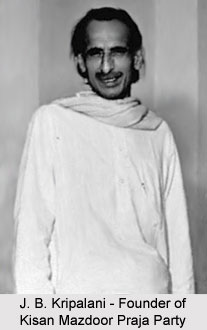 The Kisan Mazdoor Praja Party (KMPP) was an erstwhile Indian socialist political party. At present the Kisan Mazdoor Praja Party is defunct but is still recognized by the Election Commission of India as it contested in the very first parliamentary elections in India in the year 1951. The socialist party contested in 16 Indian states and won 9 seats in the Lok Sabha, which included 6 seats in the state of Mysore, and 1 seat in Delhi, Vindhya Pradesh province and the state of Madras, which is now known as Chennai. The Kisan Mazdoor Praja Party also won 5.8% of the total votes in the first parliamentary elections in independent India.
The Kisan Mazdoor Praja Party (KMPP) was an erstwhile Indian socialist political party. At present the Kisan Mazdoor Praja Party is defunct but is still recognized by the Election Commission of India as it contested in the very first parliamentary elections in India in the year 1951. The socialist party contested in 16 Indian states and won 9 seats in the Lok Sabha, which included 6 seats in the state of Mysore, and 1 seat in Delhi, Vindhya Pradesh province and the state of Madras, which is now known as Chennai. The Kisan Mazdoor Praja Party also won 5.8% of the total votes in the first parliamentary elections in independent India.
Jivatram Bhagwandas Kripalani or J.B. Kripalani, also known as Acharya Kripalani, established the Kisan Mazdoor Praja Party (KMPP) in June 1951. He also served as the chairman of the Praja Socialist Party (PSP) and was appointed as the president of the Indian National Congress during the partition of India and the Indian independence 1947. The party was formed mostly with Indian National Congress dissidents. Tanguturi Prakasam Pantulu and Dr. Prafulla Chandra Ghosh, two of the most prominent members of the Kisan Mazdoor Praja Party (KMPP) had served as the chief ministers of Andhra state and West Bengal respectively. Later in the year 1952, the Kisan Mazdoor Praja Party was merged with the Socialist Party in order to form the Praja Socialist Party (PSP). The Praja Socialist Party (PSP) was dissolved in the year 1972.
This article is a stub. You may enrich it by adding more information to it. You can send your write-up at content@indianetzone.com



















